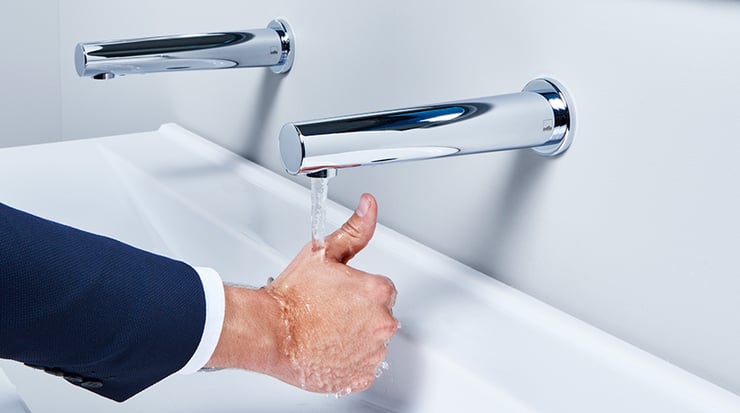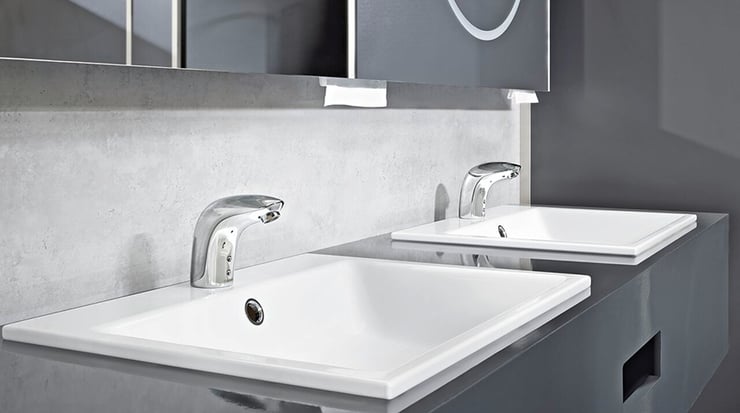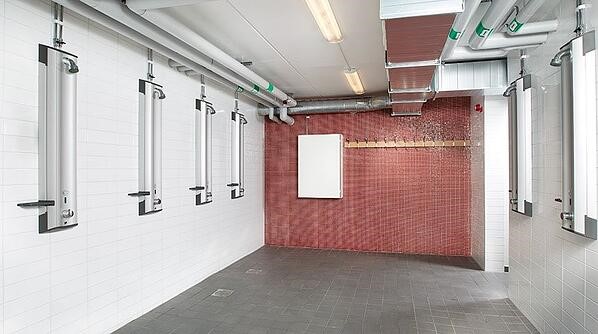Saving water in larger buildings isn’t always a hefty task: from detecting leaks to installing water-saving fixtures, here are 5 easy tips that will help you get things right.

Touchless faucets are a great way to save water in public buildings
Commercial buildings include multiple systems that rely on significant amounts of water. And we’re talking about millions of litres annually. It is estimated that a building around 20,000 square meters consumes over 20 million litres of water every single year. These could be anything, from hospitals to schools, offices and hotels.
It is estimated that a building around 20,000 square meters consumes over 20 million litres of water every single year.
And as planners, architects and engineers are paying increased attention to water conservation – they’ve discovered smart and easy ways to prevent unnecessary waste.
There are many great solutions out there waiting to be explored and exploited. We gathered a few smart tips from the experts to help you make the most of your next big project.
 Touchless faucets can help save water and energy up to 50%
Touchless faucets can help save water and energy up to 50%
1. Install plumbing fixtures with low-flow rates
In recent years, thanks to great technological developments, many high-flow water systems have been replaced with low-flow systems designed to consume a lot less water. These include aerators and flow limiters for faucets, showerheads, hand showers and high-efficiency toilet flushing.
Especially, in public buildings that include swimming pools and locker rooms, touchless shower panels are ideal for water-saving – activating only when they’re needed.
Retrofitting a large, commercial building with a new set of water-conserving fixtures might seem expensive. However, the water saved will save you money and help the planet in the long run. What’s more – if you decide to install touchless faucets, the fixtures can both save water consumption by up to 50% and cut your energy bills too.
Touchless faucets by Oras are equipped with Bluetooth technology which connects the faucet to an app. This can easily help keep track of the daily water consumption and usage volume throughout the building. Moreover, with the app one can easily adjust settings such as after-flow time or sensor sensitivity, both of which can have an impact on the total water consumption figures.
 Touchless shower panels are a great fit for public swimming halls or locker rooms.
Touchless shower panels are a great fit for public swimming halls or locker rooms.
2. Regulate the building’s water pressure
Water pressure usually indicates the health of your building’s water system. The pressure should be somewhere between 65psi and 80psi. If the pressure is higher than that, it could damage the pipes and lead to bursts.
3. Install smart water metering systems
This will give you an overview of your building’s daily and hourly water consumption, providing you with all the data you need to regulate your water usage. The system usually also provides you with the amount of water usage the building is costing you.
4. Leak Repair
A regular, simple check of the piping system will allow you to save litres of water every year. And this should not only apply to pipes but also to faucets and showers.
A leaky faucet or showerhead can waste up to 7000 litres a year
To put things in perspective, a faucet or showerhead can waste up to 21 litres per day. That’s over 7,000 litres a year – and multiply that with the number of faucets and showers that are installed in the building. That’s a lot of water (and money) going to waste.
5. Install sensors on your irrigation system
If your building includes an irrigation system, there are easy ways to cut down on water consumption. Simply install detectors that will detect precipitation and the irrigation system won’t activate. Once the rain stops, the sensors will detect it and watering will resume.
Saving water in a public building doesn’t always require fancy machinery or meticulous planning. Some solutions are quite straightforward: avoid leaking faucets, make sure the water pressure isn’t too high, and prevent some of that rain from just going to waste.






 Touchless faucets can help save water and energy up to 50%
Touchless faucets can help save water and energy up to 50% Touchless shower panels are a great fit for public swimming halls or locker rooms.
Touchless shower panels are a great fit for public swimming halls or locker rooms.